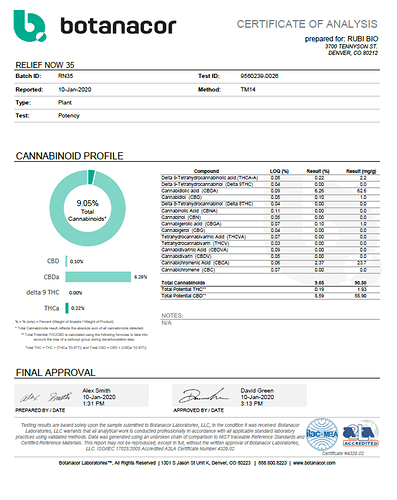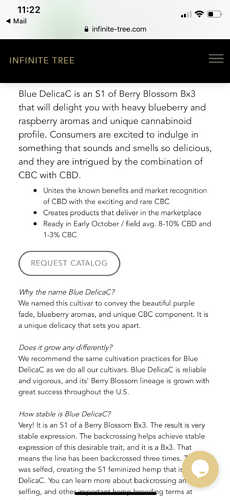I have a pheno of Relief Now that shows a 2.5:1 ratio CBD:CBC. Also has a 30:1 CBD:THC ratio which is pretty solid. I was wondering what interest there is in CBC. Are we going to see new CBC-dominant varieties in 2021 and high prices for CBC concentrates? What about other minor cannabinoids like the varins CBDV and THCV?
You have any seeds for sale?
I just have it as a clone in TC currently! Once we get through this season we will be producing this in the greenhouses over the winter
They claim some plant have been up to 69% CBC… but the varieties were breed out. So high CBC plants do exist/have existed.
I think CBC has great potential and unique pharmacology. I am starting to test edibles with it. It should be taken along other cannabinoids (i.e CBD /THC /CBG).
Very nice low thc content. Other than cbg, are there any strains grown for minor cannabinoids that would pass the .3% total thc limit for hemp that is supposed to be coming in 2021?
If anyone knows where I can get some good CBC genetics, please dm!
I’ve got synthetic CBC oil with 96% CBC. It is bio-identical to plant based CBC, with no heavy metal, pesticide or solvent issues. Call/text me at 727-543-3419 with any questions or for a COA.
Seconded!
If you made your CBC synthetically, then you have the racemic product (±)-Cannabichromene.
Although cbc is not enantiopure in nature, it is not a racemate.
It is true that racemic (±)-CBC will elute at the same retention time as CBC in an HPLC or GC. So a COA for synthetic compounds will not suffice. With access to a university lab one would be be able to tell pretty quickly whether it’s of synthetic origin.
Unless you have a special method for chiral resolution to produce enantiopure products, please do make claims that your synthetic CBC is “bio-identical.” It’s bad for business to make such claims to a community full of such knowledgeable people.
TC ? Tahoe City?
tissue culture!
You don’t know what synthetic route was taken to make the CBC, so you can’t assume it’s racemic.
You have no idea what the natural enantiomeric ratio of CBC is. It may be racemic, fixed at a certain ratio, enantiopure, or variable, so you cannot make any comparison between his synthetic material and a natural product.
In fact, the case is still out on the natural enantiomeric ratio of CBC in cannabis.
“CBC is also a chiral cannabinoid, but it represents a rare case of a natural racemate, although the same authors reported an excess of one enantiomer in the Bedrocan variety [1,40, 111].”
Citti et al. 2020. Pitfalls in the analysis of phytocannabinoids in cannabis inflorescence.
https://sci-hub.se/10.1007/s00216-020-02554-3
The synthetic route the chemists used who made him the CBC may be enantioselective and thus separation of enantiomers may not be necessary.
These guys supposedly have a CBC cultivar but I have not been able to get a hold of them.
The most economical and efficient CBC synthesis is to use CGB as a starting material. If you look at the structure of CBG, there aren’t a lot of options for using something like a stereospecific catalyst. Assuming the CBC is made from CBG, you more than likely will end up with an enantiomeric product. If you know of a reagent capable of making this stereospecific isomerization happen, do tell.
I found an article entitiled Stereospecific cyclizations and isomerizations of cannabichromene and related cannabinoids, but the title is misleading and the paper talks about making stereospecific products resulting from the cylcization of CBC into iso-thc, not about CBC itself.
That’s why I hinted at the need for chiral resolution.
It has been widely reported that CBC is a natural racemate but Mazzoccanti et al. 2017 concluded that CBC as a natural product is actually a scalemic mixtutre and not racemic. The natural enantiomeric ratio was determined in that study.
“Notably, for ‘‘CBC’’, we found that, instead of being a racemate, the ee is about 25% (equally measurable on both the columns), which means that it occurs as a scalemic mixture.”
If made from natural CBG it will be not be chiral, since CBG is achiral… Take an optical rotation or send to a lab for analysis of optical activity.
Very good question to bring up… if it is racemic I would be hesitant to sell it, unless CBC is a natural racemate. Under FDA guidelines the enantioners must be tested separately.
Lastly, an enantioselective synthesis would be possible, but unlikely. It would make the synthetic cost high $$$ compared to racemic synthesis. Some say CBC is naturally racemic. I will investigate this further ![]()
It certainly wasn’t my intent to misrepresent our synthetic CBC. I’ve asked our Chief Scientist to respond. In the interim, I’d welcome the opportunity to send you our COA and white paper. If that’s of interest to you, please give me your email address.
This just in from our CEO:
With the disclaimer that I am NOT the chemist, the short answer is that yes, we currently offer a racemic CBC. (While we can and have made enantiopure products, it is cost prohibitive at this time.) THAT SAID, we’ve also analyzed samples of plant-derived CBC, and we’ve found that it is also not enantiopure. Rather, it appears to be a scalemic mixture that is 1) variable, and 2) itself nowhere close to a pure enantiomer. Based on this analysis, if one were to do an animal study with our CBC vs. plant derived CBC, the results would almost certainly fall within the error bars, and in that sense they would be considered bioidentical.
It’s not actually a CBC dominant strain, just has higher levels of CBC.
It’s still 8-10% CBD and only 1-3% CBC.
It got my attention too but after looking into it I wasn’t very impressed.
@TrilogeneSeeds.com have seeds from a high(er) CBC cultivar. I remember its about a 4:1 CBD:CBC ratio. The cultivar is called TBB S1 in their catalog, its a Berry Blossom Bx.
I am not affiliated with them and have never bought their seeds, but I am connected through LinkedIn and other social media, and have heard good things.
How’s this strain performing in vitro? I would be interested in replicating. I have a small lab in GA.

